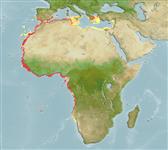>
Carangiformes (Jacks) >
Carangidae (Jacks and pompanos) > Caranginae
Etymology: Caranx: French, carangue, the name of a Caribbean fish; 1836 (Ref. 45335).
Environment: milieu / climate zone / depth range / distribution range
بوم شناسي
دريايي; لب شور موجوداتی که در محدوده وسیعی از آبهای آزاد از نزدیک بستر و یا روی کف بستر، در قسمت های میان آبی تا سطح آب و در برخی گونه ها با قابلیت پرواز، زندگی و تغذیه می کنند.; تغييرات عمق 30 - 200 m (Ref. 27584), usually 30 - 50 m (Ref. 26999). Subtropical; 15°C - 22°C (Ref. 57055); 39°N - 22°S, 19°W - 36°E
Eastern Atlantic: Morocco to Angola (Ref. 4225, 57392), including the Mediterranean along the African coast. Range reported to extend south to Namibia (Ref. 27121).
Length at first maturity / Size / Weight / سن
Maturity: Lm ?, range 20 - ? cm
Max length : 60.0 cm TL جنس نر / بدون خواص جنسي; (Ref. 57392); common length : 35.0 cm TL جنس نر / بدون خواص جنسي; (Ref. 3397); بيشينه وزن گزارش شده: 1.0 kg (Ref. 27584)
خارهاي باله پشتي (کل) : 9; شعاع نرم باله پشتي (کل) : 28 - 32; خارهاي باله مخرجي: 3; شعاع نرم باله مخرجي: 25 - 28. Diagnosis: body elongate and slightly compressed, its depth comprised from 3.8 to 4.4 times in fork length; eye posteriorly with a well developed adipose eyelid; 2 well separated dorsal fins, 1st with 8 spines, 2nd with 1 spine and 28-32 soft rays; anal fin with 2 detached spines, followed by 1 spine and 25-28 soft rays; last dorsal and anal ray transformed into a partially separate finlet, connected to the preceding ray by a low interradial membrane; pectoral fins short (comprised from 1.0 to 1.2 times in head length); scales small and cycloid; curved part of lateral line with 45-55 scales and 0-3 scutes, straight part with 0-8 scales and 24-32 scutes (Ref. 57392).
Coloration: back brownish to olivaceous, sides light olivaceous to whitish; a narrow yellowish band sometimes extending from head to caudal-fin base; a black spot on upper margin of gill cover; a black blotch with a narrow light distal margin present on second dorsal-fin lobe (Ref. 57392).
Form schools. They occur frequently near the bottom, mostly in depths of 30 to 50 m. Also pelagic and found near the surface at times. Entering brackish-water lagoons and estuaries (Ref. 57392). Feed on small fish and invertebrates (Ref. 3195). Spawning grounds are located in shallow waters (Ref. 57055). Eggs are pelagic (Ref. 4233).
A partial spawner (Ref. 57055).
Smith-Vaniz, W.F., J.-C. Quéro and M. Desoutter, 1990. Carangidae. p. 729-755. In J.C. Quero, J.C. Hureau, C. Karrer, A. Post and L. Saldanha (eds.) Check-list of the fishes of the eastern tropical Atlantic (CLOFETA). JNICT, Lisbon; SEI, Paris; and UNESCO, Paris. Vol. 2. (Ref. 7097)
وضعيت در فهرست قرمز IUCN (Ref. 130435: Version 2024-2)
خطر برای انسان ها
Harmless
استفاده انسانی
ماهي گيري – شيلات: تجاري
ابزارها
گزارش های ويژه
بارگيری XML
منابع اينترنتي
Estimates based on models
Preferred temperature (Ref.
123201): 16.2 - 25.6, mean 19.2 °C (based on 58 cells).
Phylogenetic diversity index (Ref.
82804): PD
50 = 0.5000 [Uniqueness, from 0.5 = low to 2.0 = high].
Bayesian length-weight: a=0.01514 (0.01231 - 0.01861), b=2.95 (2.92 - 2.98), in cm total length, based on LWR estimates for this species (Ref.
93245).
Trophic level (Ref.
69278): 3.6 ±0.59 se; based on food items.
Generation time: 6.9 ( na - na) years. Estimated as median ln(3)/K based on 2
growth studies.
جهندگی (Ref.
120179): متوسط, كمينه زمان لازم براي دو برابر شدن جمعيت 4/1 – 4/4 سال (K=0.16-0.3; Fec = 480,000).
Prior r = 0.32, 95% CL = 0.21 - 0.48, Based on 1 data-limited stock assessment.
Fishing Vulnerability (Ref.
59153): Moderate vulnerability (36 of 100).
Climate Vulnerability (Ref.
125649): Low to moderate vulnerability (30 of 100).
Nutrients (Ref.
124155): Calcium = 30.7 [15.4, 66.6] mg/100g; Iron = 0.578 [0.312, 1.174] mg/100g; Protein = 19.1 [16.8, 21.6] %; Omega3 = 0.342 [0.178, 0.659] g/100g; Selenium = 38.9 [18.6, 89.4] μg/100g; VitaminA = 18.8 [6.4, 46.7] μg/100g; Zinc = 0.471 [0.325, 0.712] mg/100g (wet weight); based on
nutrient studies.
